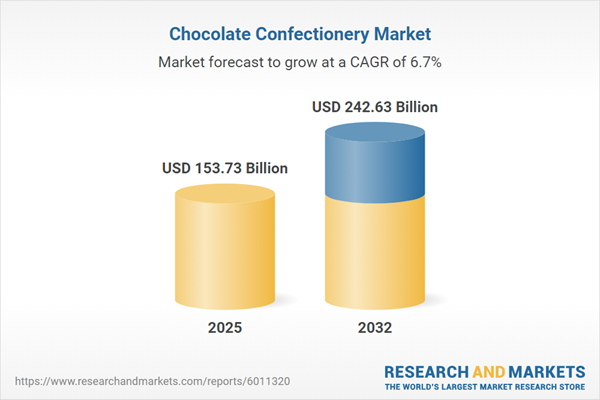Speak directly to the analyst to clarify any post sales queries you may have.
The chocolate confectionery market is evolving rapidly, shaped by shifting consumer demands, innovation in production and distribution, and a heightened focus on sustainability. Senior decision-makers navigating this environment must balance emerging trends with operational imperatives to remain competitive and capture new growth.
Market Snapshot: Chocolate Confectionery Market Size and Growth
The global chocolate confectionery market grew from USD 144.66 billion in 2024 to USD 153.73 billion in 2025. Projected to maintain a compound annual growth rate (CAGR) of 6.67%, the sector is forecast to reach USD 242.63 billion by 2032. This momentum underscores sustained demand, powered by evolving consumer preferences, product innovation, and expansion across diverse regional markets.
Scope & Segmentation of the Chocolate Confectionery Market
This comprehensive report outlines major market segments and regions, providing an in-depth analysis designed for industry leaders.
- Type – Dark Chocolate, Milk Chocolate, White Chocolate
- Form – Bars, Blocks, Chips & Bites, Syrup
- Ingredients – Non-Organic, Organic
- Flavor – Classic Chocolate, Flavored Chocolate
- Distribution Channel – Offline (Convenience Stores, Specialty Shops, Supermarkets & Hypermarkets), Online (Direct Sales, E-commerce)
- End-User – Commercial (Bakeries, Cafes, Restaurants), Individuals
- Geographies Covered – Americas (including United States, Canada, Mexico, Brazil, Argentina, Chile, Colombia, Peru), Europe, Middle East & Africa (including United Kingdom, Germany, France, Russia, Italy, Spain, Netherlands, Sweden, Poland, Switzerland, United Arab Emirates, Saudi Arabia, Qatar, Turkey, Israel, South Africa, Nigeria, Egypt, Kenya), Asia-Pacific (including China, India, Japan, Australia, South Korea, Indonesia, Thailand, Malaysia, Singapore, Taiwan)
- Key Companies Profiled – Major multinationals and regional leaders, including ACK Chocolate Industries LLC, Barry Callebaut AG, The Hershey Company, Ferrero Group, Mars, Incorporated, Nestlé S.A., Mondelēz International, Inc., Chocoladefabriken Lindt & Sprüngli AG, Lotte Corporation, and others
The segmentation provides granular understanding of how new flavors, forms, and channel strategies are expanding revenue potential and meeting diverse market needs. Digital transformation and product innovation continue to drive competition, with regional varietals and consumer priorities shaping go-to-market strategies.
Key Takeaways for Senior Decision-Makers
- Consumer demand is broadening beyond classic profiles, driven by interest in premium, health-focused, and ethically sourced chocolate.
- Digital innovation, such as e-commerce and AI-driven personalization, is redefining sales channels and consumer engagement.
- Transparency in sourcing and sustainability measures is critical for long-term brand credibility and regulatory compliance.
- Regional diversity requires nuanced strategies, as local tastes, regulatory frameworks, and distribution landscapes vary markedly.
- Collaboration with upstream suppliers and specialty producers can enhance differentiation and reduce supply chain risk.
- Flexible manufacturing and rapid innovation cycles support adaptation to shifts in consumer tastes and regulatory requirements.
Tariff Impact on the Chocolate Confectionery Sector
The introduction of new U.S. tariff measures in 2025 has influenced trade patterns, cost structures, and sourcing decisions across the chocolate confectionery industry. These changes prompted companies to diversify suppliers, explore near-shoring, and localize production to balance increased costs and manage supply chain complexities. Currency fluctuations have acted as an additional challenge, highlighting the need for robust pricing strategies and contractual agility.
Methodology & Data Sources
The chocolate confectionery market analysis applies a blend of qualitative and quantitative techniques. It integrates primary research from industry executives and supply chain participants with secondary reviews of trade publications, technical reports, and regional financial data. Rigorous validation processes, including contract reviews and scenario mapping, ensure credible, transparent, and actionable insights.
Why This Report Matters for Chocolate Confectionery Industry Leaders
- Enables informed decision-making through comprehensive segmentation, covering all leading and emerging market players.
- Provides actionable perspectives on regulatory, technological, and consumer trends shaping both near-term and long-term strategies.
- Supports risk mitigation, from sourcing diversification to adopting sustainable and digital-first operational models.
Conclusion
The chocolate confectionery market is positioned for dynamic growth, with evolving consumer priorities, regulatory changes, and technological advancement offering both opportunities and challenges. Leaders who act decisively on these trends will sustain competitive advantage and drive value creation in the global marketplace.
Additional Product Information:
- Purchase of this report includes 1 year online access with quarterly updates.
- This report can be updated on request. Please contact our Customer Experience team using the Ask a Question widget on our website.
Table of Contents
3. Executive Summary
4. Market Overview
7. Cumulative Impact of Artificial Intelligence 2025
Companies Mentioned
The companies profiled in this Chocolate Confectionery market report include:- ACK Chocolate Industries LLC
- Al Nassma Chocolate LLC
- Askinosie Chocolate, LLC
- August Storck KG
- Barry Callebaut AG
- Cacau Show
- Chocoladefabriken Lindt & Sprüngli AG
- Endangered Species Chocolate
- Ezaki Glico Co., Ltd.
- Ferrero Group
- FUJIYA CO., LTD.
- Lake Champlain Chocolates
- LEE Chocolate
- Lotte Corporation
- Mars, Incorporated
- Max Felchlin AG
- Meiji Holdings Co., Ltd.
- Mondelēz International, Inc.
- Morinaga & Co., Ltd.
- Nestlé S.A.
- Notions Group
- Orion Corporation
- pladis Foods Ltd by Yıldız Holding
- Raaka Chocolate Ltd.
- The Hershey Company
- Tony’s Chocolonely Ltd.
- Zokolat
Table Information
| Report Attribute | Details |
|---|---|
| No. of Pages | 181 |
| Published | November 2025 |
| Forecast Period | 2025 - 2032 |
| Estimated Market Value ( USD | $ 153.73 Billion |
| Forecasted Market Value ( USD | $ 242.63 Billion |
| Compound Annual Growth Rate | 6.6% |
| Regions Covered | Global |
| No. of Companies Mentioned | 28 |









